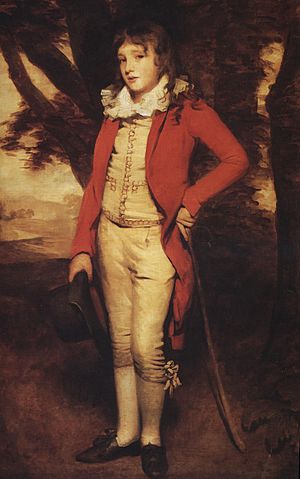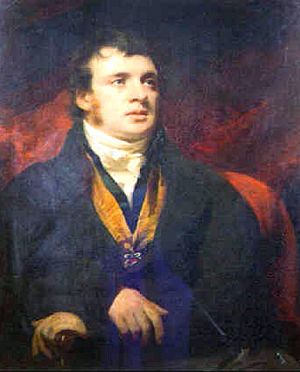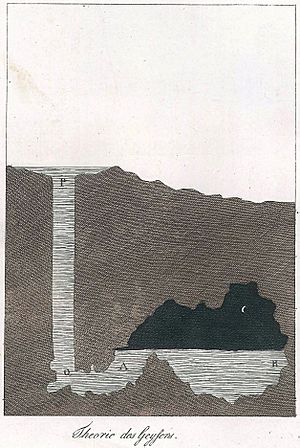Sir George Mackenzie, 7th Baronet facts for kids
Sir George Steuart Mackenzie (born June 22, 1780 – died October 26, 1848) was a Scottish scientist who studied rocks and minerals (a geologist), chemicals (a chemist), and helped improve farming methods. He was also a Baronet, which is a special title passed down in families.
Contents
About Sir George's Life
George Steuart Mackenzie was born on June 22, 1780. He was the only son of Major General Sir Alexander Mackenzie. George was taught at home for a while, then spent a year at Edinburgh's High School. After that, he studied science at the University of Edinburgh.
In 1796, when he was just 16, his father passed away. This meant George became the 7th Baronet of Coul.
He became known in the science world around 1800. He did experiments to show that diamonds are made of carbon, just like coal! It's said he even used his mother's jewels for these tests.
In 1799, he became a member of the Royal Society of Edinburgh, a famous group for scientists. Later, in 1815, he also joined the Royal Society of London. He was also the head of the Caledonian Horticultural Society, which focused on gardening and plants.
Sir George was a student and friend of Robert Jameson, another important scientist. He spent a lot of time studying rocks, minerals, and the Earth's structure. His interest led him to travel to Iceland in 1810 with his friends Henry Holland and Richard Bright. He wanted to learn more about the geology there.
To understand Iceland's geology even better, Sir George visited the Faroe Islands in 1812. When he returned, he shared his findings with the Royal Society of Edinburgh.
Sir George was also involved in a difficult time known as the Highland Clearances. In 1819-1820, families in places like Inverlael and Balblair were forced to leave their homes. Landowners did this to make space for sheep farming or other uses. It was a very tough time for these families, and many had to move or even leave Scotland.
Sir George Mackenzie passed away at his home in Edinburgh on October 26, 1848.
Sir George's Books and Ideas
In 1811, Sir George, Bright, and Holland published a book called Travels in Iceland. Sir George wrote about their journey and the parts about Iceland's minerals, farming, and trade. This book was well-received.
In Travels in Iceland, Sir George was the first to suggest how geysers work. Geysers are hot springs that shoot water and steam into the air. He thought that a geyser has a large underground cave connected to the surface by a twisty pipe.
He also wrote a report for the Board of Agriculture called General View of the Agriculture of Ross and Cromarty in 1813. From 1826 to 1848, he wrote many papers about the "Parallel Roads of Lochaber," which are strange shelf-like features on hillsides. However, his ideas about them were not widely accepted.
Here are some other books he wrote:
- Treatise on the Diseases and Management of Sheep, 1807.
- Travels in the Island of Iceland during the Summer of the Year MDCCCX, 1811.
- An Account of some Geological Facts observed in the Faroe Islands, 1815.
- An Essay on some Subjects connected with Taste, 1817.
- Illustrations of Phrenology. With Engravings, 1820. This book included an engraving of William Godwin.

- Documents laid before … Lord Glenelg … relative to the Convicts sent to New South Wales, 1836.
- General Observations on the Principles of Education, &c., 1836.
- On the most Recent Disturbance of the Crust of the Earth in respect to its Suggesting an Hypothesis to Account for the Origin of Glaciers, a paper from 1840.
Sir George's Family Life
Sir George Mackenzie married Mary Macleod in 1802. They had seven sons and three daughters. One of their sons, Robert Ramsay Mackenzie, later became the Premier of Queensland, which is like the head of the government for a state in Australia. After Mary passed away in 1835, Sir George married Catherine Jardine in 1836. They had one son together.
Honors and Recognition
- A place called Mackenzie Bay in Greenland was named after him by William Scoresby, another explorer and scientist.




